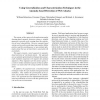Free Online Productivity Tools
i2Speak
i2Symbol
i2OCR
iTex2Img
iWeb2Print
iWeb2Shot
i2Type
iPdf2Split
iPdf2Merge
i2Bopomofo
i2Arabic
i2Style
i2Image
i2PDF
iLatex2Rtf
Sci2ools
NDSS
2006
IEEE
2006
IEEE
Using Generalization and Characterization Techniques in the Anomaly-based Detection of Web Attacks
The custom, ad hoc nature of web applications makes learning-based anomaly detection systems a suitable approach to provide early warning about the exploitation of novel vulnerabilities. However, anomaly-based systems are known for producing a large number of false positives and for providing poor or non-existent information about the type of attack that is associated with an anomaly. This paper presents a novel approach to anomalybased detection of web-based attacks. The approach uses an anomaly generalization technique that automatically translates suspicious web requests into anomaly signatures. These signatures are then used to group recurrent or similar anomalous requests so that an administrator can easily deal with a large number of similar alerts. In addition, the approach uses a heuristics-based technique to infer the type of attacks that generated the anomalies. This enables the prioritization of the attacks and provides better information to the administrator. Our approach ...
Computer Networks | Large Number | Learning-based Anomaly Detection | NDSS 2006 | Suitable Approach |
Related Content
| Added | 12 Jun 2010 |
| Updated | 12 Jun 2010 |
| Type | Conference |
| Year | 2006 |
| Where | NDSS |
| Authors | William K. Robertson, Giovanni Vigna, Christopher Krügel, Richard A. Kemmerer |
Comments (0)

